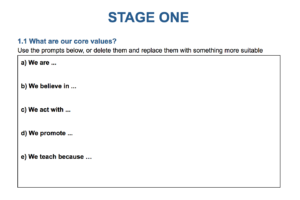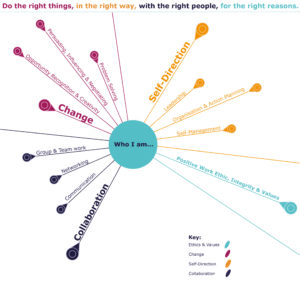Demystifying the CAIeRO: Programme level design
A typical module CAIeRO will often start with programme level exercises, such as agreeing or reviewing the mission, ‘look and feel’, and learning outcomes for the programme as a whole. It’s in the interests of the teaching team – and the students – to (re-)use these elements of the programme’s blueprint when designing at module level – it helps to promote coherence and consistency, and to minimise unintentional duplication. But focusing on the module level, while necessary for planning and supporting good learning, can sometimes lead to a fragmented approach over time. Sometimes you need to take a step back to see the bigger picture.
The Learning Design team are often asked to support teams who need to review and make changes at the programme level. As with module CAIeROs, the reasons for this can be many and varied: maybe it’s a new programme or pathway; maybe there have been significant changes in staffing or in the subject area; maybe the team want to respond to specific institutional agendas or to challenges identified in student feedback or grades; maybe it’s just been a long time since the programme was reviewed as a whole and the team want to ensure that iterative changes at the module level haven’t affected the coherence of the award map. Programme level CAIeROs can be as diverse and bespoke as module level ones, but there are some common goals, and as a team we are always refining our toolkit to support them. You may find you use some of the steps below more or less depending on your needs, but this post, along with the Programme Planner developed by our very own Rob Farmer, will give you an idea of some of the approaches available to you.
Before you start: (Re)establishing consensus
The programme ‘blueprint’
As always we suggest you start by defining the intended outcomes, if you don’t have these already. Although programme outcomes are slightly different to module outcomes, because they are not directly assessed, many of the same principles still apply. They need to be aligned with national quality standards (e.g. the FHEQ and Subject Benchmark Statements), and with any relevant Professional, Statutory and Regulatory Body (PSRB) requirements if the programme is accredited – and of course they have to make sense to non-experts, including students and employers. Once you have your programme outcomes, you can start thinking about breaking them down into chunks of learning that will form your taught modules – or, for existing programmes, reviewing how well they map to the modules you already have in place. Do you need to add, remove, combine or split anything?
Sequencing learning
 Taking a programme level perspective allows you to plan the development of understanding and skills across a larger timeframe, to make sure that the scaffold is sound and your students aren’t missing a foundation piece when they reach the higher levels. To get the sequence right, you can storyboard your programme using a range of tools, from paper and post-its to Powerpoint or Popplet. Move the pieces around until the order seems logical, and think about whether each piece needs to be ‘short and fat’ (intensive) or ‘long and thin’. At this stage you might want to consider the placement of elements that are more complicated to schedule, like placements and trips, as well as those over which you have no control, like holidays and closed days.
Taking a programme level perspective allows you to plan the development of understanding and skills across a larger timeframe, to make sure that the scaffold is sound and your students aren’t missing a foundation piece when they reach the higher levels. To get the sequence right, you can storyboard your programme using a range of tools, from paper and post-its to Powerpoint or Popplet. Move the pieces around until the order seems logical, and think about whether each piece needs to be ‘short and fat’ (intensive) or ‘long and thin’. At this stage you might want to consider the placement of elements that are more complicated to schedule, like placements and trips, as well as those over which you have no control, like holidays and closed days.
Mapping assessment and feedback
It can be really useful to overlay your assessments on to your programme storyboard, to give you an idea of the mix of assessment activity and also to identify any deadline and marking ‘bottlenecks’. Programme leaders will usually collate details of the summative assessments across a programme, because this information is required for processes like validation, but we would encourage you to do this for your formative assessment opportunities too. This will allow you to easily see the turnaround time and where students will receive their feedback – and to identify whether it is timely enough to be useful for the next summative task! If you don’t know yet how your modules will be assessed, make a note to come back to this step, or keep a ‘work in progress’ version that you can update with more detail as you go on.
Key skills and ChANGE skills
Programme design can be a complex business – and this is before you even get in to the details of the individual modules! We recommend that teams who have a lot to do at the programme level leave at least a full day for this type of work, before moving on to the module level CAIeROs.
This is one in a series of posts about the CAIeRO process. To see the full list, go the original post: De-mystifying the CAIeRO.
Need a CAIeRO? Email the Learning Design team at LD@northampton.ac.uk.
Recent Posts
- Blackboard Upgrade – December 2025
- Preparing for your Physiotherapy Apprenticeship Programme (PREP-PAP) by Fiona Barrett and Anna Smith
- Blackboard Upgrade – November 2025
- Fix Your Content Day 2025
- Blackboard Upgrade – October 2025
- Blackboard Upgrade – September 2025
- The potential student benefits of staying engaged with learning and teaching material
- LearnTech Symposium 2025
- Blackboard Upgrade – August 2025
- H5P (HTML5 package) content types meets the needs of Jim Atkinson, Staff Development Trainer
Tags
ABL Practitioner Stories Academic Skills Accessibility Active Blended Learning (ABL) ADE AI Artificial Intelligence Assessment Design Assessment Tools Blackboard Blackboard Learn Blackboard Upgrade Blended Learning Blogs CAIeRO Collaborate Collaboration Distance Learning Feedback FHES Flipped Learning iNorthampton iPad Kaltura Learner Experience MALT Mobile Newsletter NILE NILE Ultra Outside the box Panopto Presentations Quality Reflection SHED Submitting and Grading Electronically (SaGE) Turnitin Ultra Ultra Upgrade Update Updates Video Waterside XerteArchives
Site Admin



